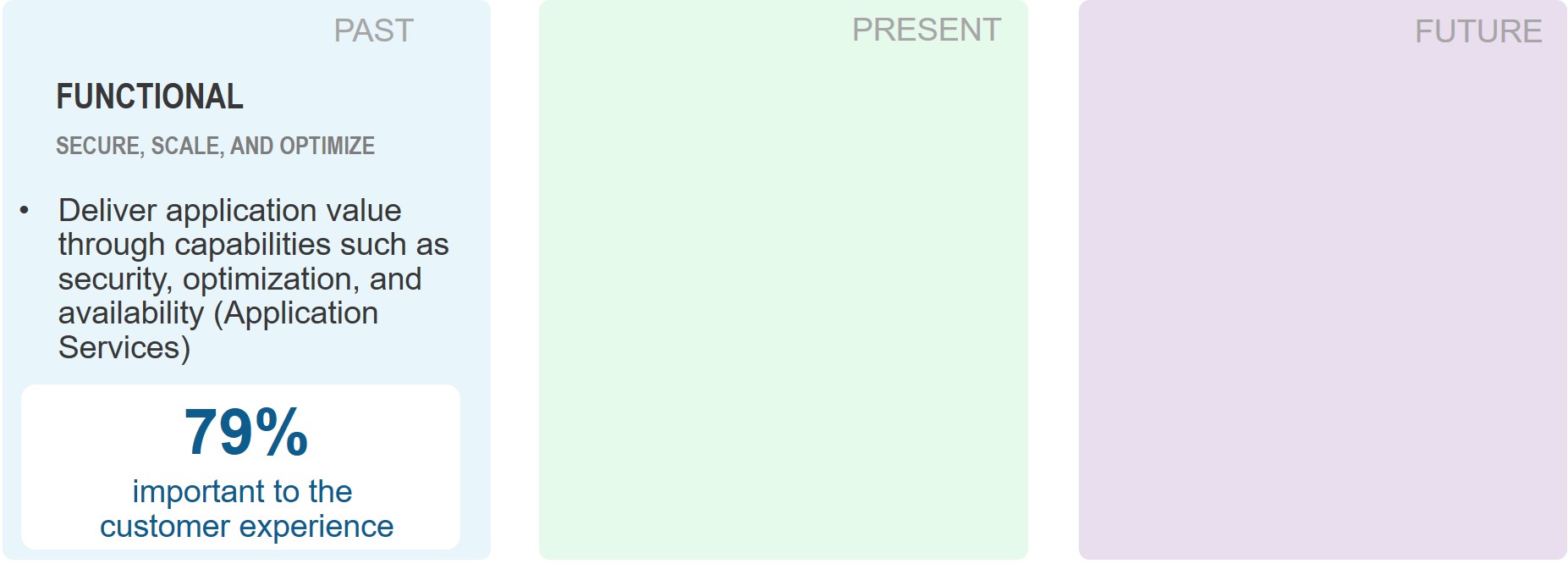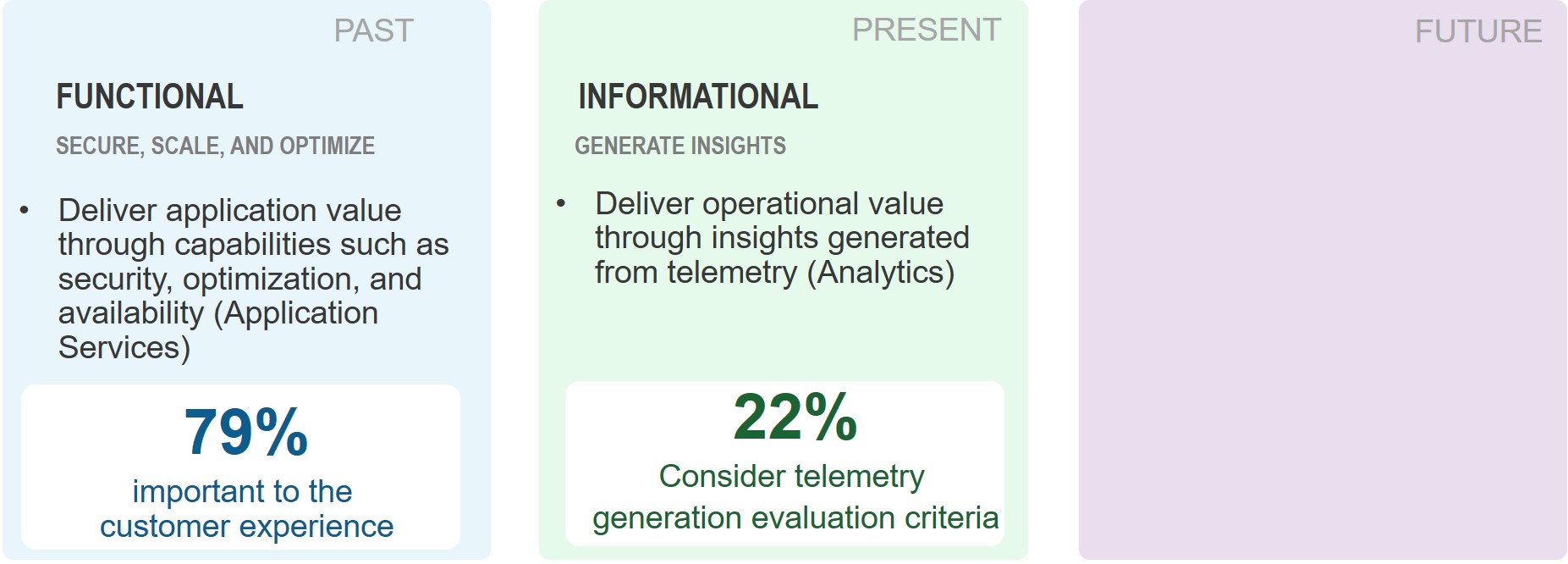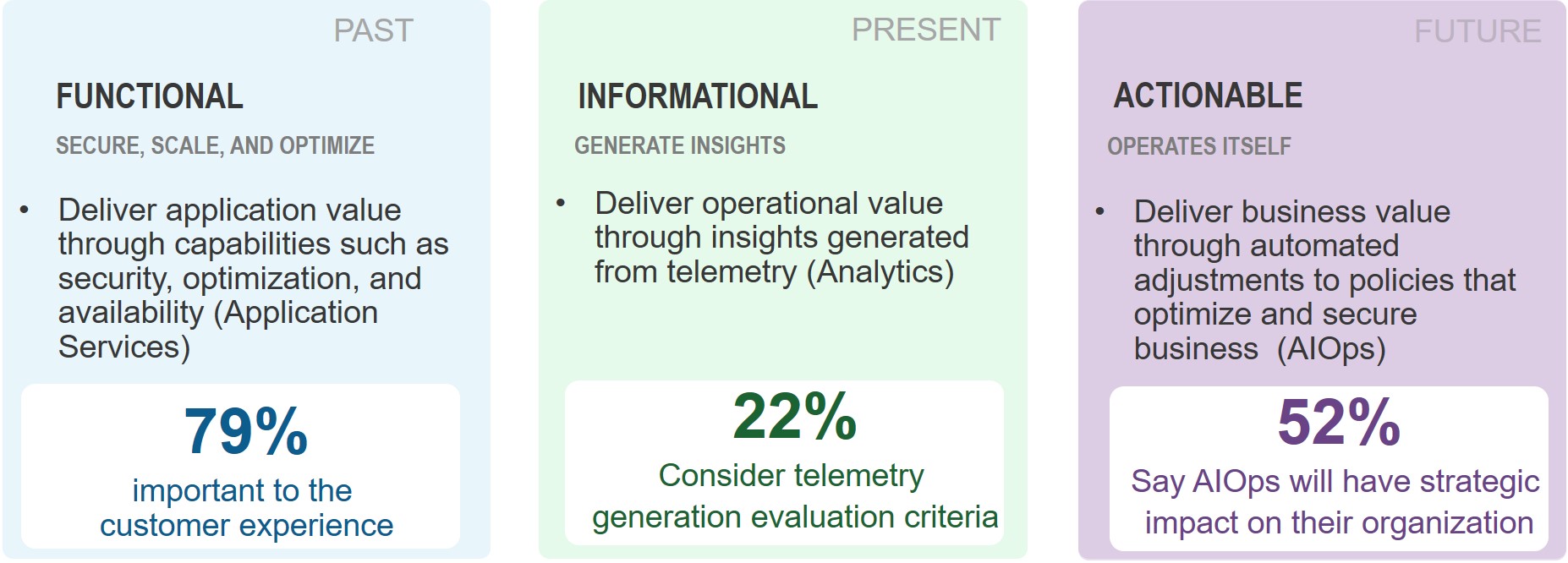Stand der Bewerbungsstrategie 2021: Aufschlüsselung des aktuellen und zukünftigen Stands der Anwendungssicherheit und -bereitstellung*
*die Technologien, die früher als Anwendungsdienste bekannt waren
Möglicherweise haben Sie im letzten Jahr einige Änderungen bei F5 bemerkt. Erstens sind wir jetzt nur F5. Nicht F5 Networks. Einfach F5. Denn ehrlich gesagt war unser Schwerpunkt nie auf das Netzwerk gerichtet. Das war ein Bereitstellungsmodell, das architektonisch Sinn ergab. Der Schwerpunkt lag und liegt jedoch auf der Frage, wie Anwendungen beschleunigt, skaliert und gesichert werden können. Das führt uns zur nächsten Änderung, nämlich die Art und Weise, wie wir beschreiben, „was wir tun“, von der Anwendung Dienstleistungen zu Anwendungssicherheit und Bereitstellungstechnologien.
Um ganz ehrlich zu sein, wurde dieser Bereich mit der Übernahme von Volterra kürzlich auf Anwendungssicherheit , -verteilung und -bereitstellung ausgeweitet.
Aber gehen wir doch eine Änderung nach der anderen an, oder? Heute möchte ich mich auf die nicht ganz so subtile Verschiebung von Anwendungsdiensten zu Anwendungssicherheits- und Bereitstellungstechnologien konzentrieren.
Anwendungsdienste
Bei der Anwendungsbereitstellung lag der Schwerpunkt früher auf der Lösung des Skalierungsproblems. Als Nächstes stand die Optimierung an, dicht gefolgt von der Sicherheit. Die Application Delivery Controller-Branche entstand bei F5 aus der Notwendigkeit heraus, alle drei Herausforderungen – Umfang, Geschwindigkeit und Sicherheit – auf kostengünstige und architektonisch effiziente Weise zu bewältigen. Von einem ADC bereitgestellte Anwendungsdienste wie Lastausgleich und Webanwendungs-Firewalls gehen auf beide Bedenken ein und meistern gleichzeitig die Herausforderung, Anwendungen bereitzustellen und zu sichern.
Der Schwerpunkt dieser Technologien lag auf den Fähigkeiten, auf den funktionalen Eigenschaften jedes Dienstes. Wie viel Bandbreite könnte eingespart werden? Wie viel schneller könnte die Reaktionszeit gemacht werden? Wie viele Angriffe konnten verhindert werden?

Dies sind nach wie vor wichtige Eigenschaften. Mehr als drei Viertel (79 %) der Teilnehmer unserer jährlichen Umfrage geben an, dass Anwendungssicherheit und Bereitstellungstechnologien wichtig sind, um ein außergewöhnliches Kundenerlebnis zu bieten. Die funktionalen Fähigkeiten dieser Technologien sind nach wie vor ein wichtiger Teil ihrer Definition.
Anwendungssicherheit und Bereitstellungstechnologien
Doch die digitale Transformation verändert das Geschäft. Der Übergang vom Physischen zum Digitalen bringt eine Abhängigkeit von der Technologie in allen Geschäftsbereichen mit sich. In der Vergangenheit haben Unternehmen den Fußgängerverkehr manuell erfasst, indem sie die Personen gezählt haben. Es verfolgte Inventar und Lagerbestände, indem es Berichte über die Datenbanken ausführte, in denen physische Dinge erfasst wurden.
Heute sind diese Prozesse integriert und erfolgen zunehmend über digitale Kanäle. Mobile Anwendungen und Websites werden standardmäßig und nicht als Luxus verwendet. Das Verständnis des „Fußgängerverkehrs“ ist heute ein digitales Anliegen und hängt in hohem Maße von den Technologien ab, die für die Bereitstellung der Anwendungen und Websites verwendet werden, die es Verbrauchern ermöglichen, Produkte zu durchsuchen und zu kaufen.

In einer standardmäßig digitalen Welt zu agieren bedeutet, dass sich die Technologien zur Sicherung und Bereitstellung von Anwendungen weiterentwickeln müssen, um den Anforderungen einer zunehmend digitalen Geschäftswelt gerecht zu werden. Dazu ist mehr erforderlich, als nur Funktionen auszuführen. Diese Technologien müssen auch Informationen über die Interaktionen generieren, bei denen diese Funktionen ausgeführt werden. Sie müssen Telemetriedaten generieren, um die Interaktion der Verbraucher mit Anwendungen durchgängig zu beschreiben und Erkenntnisse über das digitale Verhalten und die Kaufmuster zu gewinnen.
Wir beobachten, dass diese Bewegung heute an Dynamik gewinnt. Fast ein Viertel (22 %) der Unternehmen erachtet die Möglichkeit zur Generierung von Telemetriedaten bereits als wichtigen Faktor bei der Auswahl von Technologien für Anwendungssicherheit und -bereitstellung.
Ein Blick in die Zukunft
In meinem hübschen kleinen Diagramm gibt es immer noch ein leeres Kästchen, das auf die Zukunft ausgerichtet ist. Was auf Daten folgt, ist die Fähigkeit, auf der Grundlage der aus ihnen gewonnenen Erkenntnisse zu handeln. Die Zukunft der Anwendungssicherheit und Bereitstellungstechnologien beruht auf der Fähigkeit, den Kreis zwischen Erkenntnissen und Maßnahmen zu schließen, um das gewünschte Geschäftsergebnis zu erzielen.
Die Erkenntnisse können uns beispielsweise verraten, dass eine schlechte Leistung des Teils der Zahlungsabwicklung in einem Workflow dazu führt, dass täglich Tausende von Dollar an Einnahmen verloren gehen. Das ist zwar hilfreich, aber wenn wir die Ursache für die schlechte Leistung kennen – weil uns die entsprechenden Daten vorliegen –, sollten wir dann nicht auch in der Lage sein, das Problem zu beheben?
Oder vielleicht sagt uns die Erkenntnis, dass eine plötzliche Nachfrage nach einer Reihe von APIs, die von einer mobilen Anwendung verwendet werden, die unterstützenden Backend-Systeme wahrscheinlich überfordern wird. Sollten wir nicht in der Lage sein, den entsprechenden Dienst automatisch zu skalieren, um den unvermeidlichen Absturz oder die Leistungsverschlechterung zu vermeiden?

Mehr als die Hälfte (52 %) offenbaren solche Absichten und Erwartungen, wenn sie angeben, dass AIOps in den nächsten zwei bis fünf Jahren strategische Auswirkungen auf ihr Unternehmen haben wird. Die Möglichkeit, Anpassungen zur Aufrechterhaltung der Leistung und Gewährleistung der Sicherheit zu automatisieren, ist für das digitale Erlebnis von entscheidender Bedeutung. AIOps ist eine der KI-basierten Technologien, die diese Funktionen in Zukunft bereitstellen werden.
Diese sind zwangsläufig mit der Anwendungssicherheit und den Bereitstellungstechnologien verknüpft, die auf die Anpassungen reagieren können müssen. Anschließend liefern dieselben Technologien Feedback in Form von Telemetriedaten, sodass diese Anpassungen mithilfe von Analysen noch einmal verfeinert werden können. Ein geschlossener Kreislauf, der sich auf der Grundlage von Analysen im Kontext historischer und Echtzeitdaten ständig anpasst.
Wenn wir (das Unternehmens-Wir) über die Ergebnisse eines solchen geschlossenen Kreislaufsystems sprechen, nennen wir es adaptive Anwendungen .
Die Zukunft der Anwendungssicherheit und Bereitstellungstechnologien wird durch die digitale Transformation und die Notwendigkeit bestimmt, Daten zu sammeln, zu analysieren und auf ihrer Grundlage zu handeln, um Geschäftsergebnisse positiv zu beeinflussen. Die Zukunft der Wirtschaft ist digital, und das bedeutet, dass Anwendungen – und die Technologien, die sie bereitstellen und sichern – das Herzstück des Geschäfts sind.
Wenn Sie es verpasst haben, holen Sie sich unbedingt Ihr eigenes Exemplar von „State of Application Strategy 2021“ , das viele weitere Erkenntnisse und Informationen enthält.
